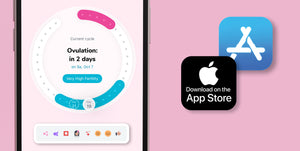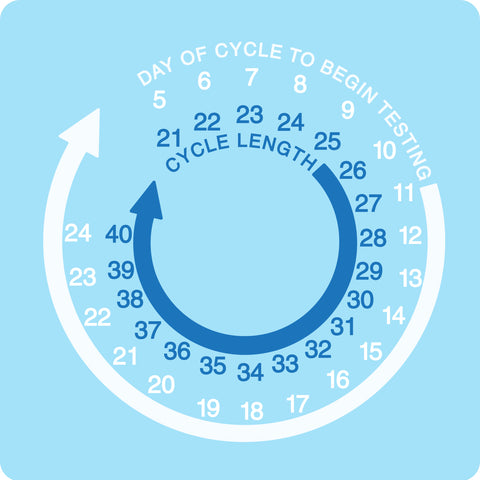
Ovulation Midstream Tests Instructions for Use
DOWNLOAD
TEST PROCEDURE
Dip the test into the urine for 5 seconds

or hold the tip in the urine stream for 10 seconds

Read results in 5 minutes
Positive (LH Surge): If two color lines are visible and the test line is equal to or darker than the control line. A positive result indicates the presence of a high amount of Luteinizing Hormone or LH surge.


Negative (No LH Surge): Only one line is visible or the test line is lighter than the control line.


WHEN TO BEGIN TESTING?
Determine the length of your menstrual cycle before the test (The length of the menstrual cycle is the duration from your first menstrual bleeding day to the day before the next bleeding begins). Please refer to the chart below to determine when you should start testing. If you do not know your cycle length, you may begin the test 11 days after your first period since the average cycle length is 28 days.

Example: If your cycle length is normally 26 days, the chart indicates testing should begin on day 10.
WHAT IS OVULATION?
Ovulation is the release of a mature egg from the ovary. It signals the beginning of your fertile period.

LH (Luteinizing Hormone) is one of the hormones produced by the pituitary gland. It is secreted at very low levels throughout your menstrual cycle. Once a developing egg follicle reaches a certain size, LH secretion surges to high levels. This hormone surge is what triggers ovulation about 24 to 48 hours later. Your LH surge is important because it initiates the beginning of ovulation. A positive result indicates the presence of a high amount of Luteinizing Hormone or LH surge.
FREQUENTLY ASKED QUESTIONS
What time of the day should I use the test? You may test any time of the day, however, it should be at approximately the same time each day. You should
How long should I continue to perform the test?
At least 5 days or until the LH surge has been detected.
My cycle length is shorter/longer than normal. Can I use this test? This test is designed to work for cycles of different lengths. Remember you may not ovulate at the same time every cycle and that the cycle may vary from month to month. You may need to test over the next few months to find out your personal cycle length average.
Once I see a positive result, when is the best time to have intercourse? Ovulation is likely to occur within 24-48 hours. This is the most fertile time. Sexual intercourse is advised within this time frame.
I have received a positive result and had intercourse during these fertile days. I have not become pregnant. What shall I do? Many factors can affect your ability to become pregnant. Often you may need to use the test kit for 3-4 months. You and your partner should consult your physician if pregnancy is not achieved after 3-4 months.
Will the amount of liquid I drink affect the result? We suggest that you limit your fluid intake for about two hours before you collect your urine. Because heavy intake of fluids prior to testing will dilute the hormone in your urine.
Can test results be interpreted after more than 5 minutes? No. Test results must be read at 5 minutes. Though a positive result should not change for several days, a negative result may change to a false positive within minutes after the end of the testing period, which would not be an accurate reading. It is always best to read the results at the 5 minute testing period and then discard the test to avoid confusion.
Can any medication or medical condition affect the result? Certain medical conditions and medications can adversely affect the performance of the test: for example if you are actually pregnant, have recently been pregnant, have reached menopause or have polycystic ovarian syndrome you may get a misleading result. This may also be true if you are taking fertility drugs containing Luteinizing Hormone or Human Chorionic Gonadotrophin (such as Pregnyl® and Profasi®). Clomiphene citrate (Clomid®) does not affect the tests, but may affect the length of your cycle and, therefore, when you should be testing.
Will oral contraceptives affect the result? After using oral contraceptives, your cycle may be irregular and take some time to stabilize again. You may wish to wait until you have had two or more normal menstrual cycles before starting to use this test.
If the ovulation test can determine when I am fertile, can I use it for contraception and birth control? We do not recommend using ovulation tests for birth control or as means of contraception. The test predicts LH for us to24-48 hours in advance of your surge, yet sperm can survive for up to 72 hours (3 days). As a result, you may still become pregnant if you test and have intercourse before you discover your surge.
I've done all the tests as instructed, but I've not yet detected my surge. What should I do? Your body produces LH (Luteinizing Hormone) every day during your
I have not seen any peak fertility days. Why is this? Your LH surge may be too low to be detected, your LH surge may be very rapid, or you may not have ovulated this cycle. This is not unusual but we recommend you see your physician if you do not see a positive result or elevated LH values for 3 consecutive cycles. If you miss a test around your LH surge you may not see an elevated LH value so remember to test twice a day in the morning and in the evening. When you test twice a day you
Related blog articles:
When is your fertile window?▶️
Ovulation Symptoms: Key Signs & Tracking Tips▶️
Pregmate App - Ovulation Tracker, Fertility and Period Calculator▶️
Conception explained. Fertilization and Implantation.▶️
Using ovulation tests to identify the most fertile days of the month▶️
Pregmate pregnancy test strips. How and when to do the test?▶️
Tracking LH surge using ovulation tests▶️
